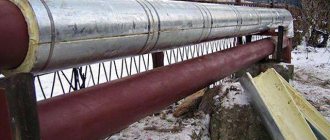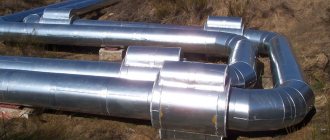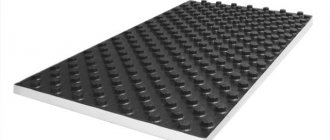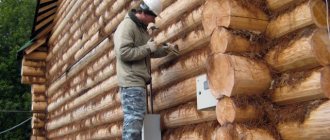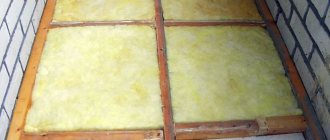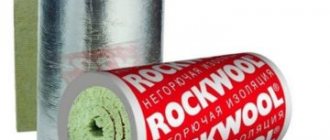Reducing the percentage of heat losses in heating communications in enterprises, utilities and private homes will save the lion's share of funds spent on heating the coolant. In this regard, any thermal insulation methods always remain relevant, especially when it comes to pipeline insulation. In heating systems of individual residential buildings, the main way to maintain a stable temperature of the coolant inside the pipes is to insulate the heating pipes. Insulating material is installed from the outside of the pipeline.
Expert opinion
Konstantin Alexandrovich
For every homeowner whose heating boiler is located at a distance from the heat exchangers (for example, in a separate utility room, outdoor boiler room), information about the main types of thermal insulators that are used to protect the pipeline from negative external influences, and about insulation of heating pipes will be useful. on the street. Materials for thermal protection can vary significantly, as well as their installation methods. Often, all the work can be done with your own hands. But you will need to carefully study the technology.
How to insulate heating pipes with your own hands
Sequence of actions in the form of step-by-step instructions:
calculation and purchase of thermal insulation material;
wrapping the pipe with foil tape or foil. The foil acts as a heat reflector;
installing insulation around the pipe. Sectional hard (casing) or soft insulation is simply “put on” the pipe. As for soft materials, they need to be cut into pieces equal in width to the diameter of the pipe. Next, wrap it around the pipe and secure it with tape, wire or plastic clamps. Hard insulation is the hardest part. From it you need to create a box around the pipe (or use pipe shells of the appropriate diameter);
inspect the insulated pipe for the presence of “cold bridges” and eliminate them;
secure the heat-insulating material to the pipe using plumbing or metallized tape;
if necessary, cover the heat-insulating material with protective material (film) and seal the joints with tape.
The costs of insulating heating pipes, despite their initial value, are quickly recouped by saving on bills for heating the house.
Insulation of water supply pipes in a private house is an important step in creating a comfortable microclimate and reducing the cost of heating premises in private and apartment buildings. In this article we will consider the insulation requirements for polypropylene pipes and whether it is necessary to insulate heating and plumbing.
In private houses, communications have two vulnerable areas for freezing. These areas are located on the street when laying communications from the well to the house or in an unheated basement. If you have not insulated the basement, then it is necessary to protect the pipes in the basement of a private house from heat loss. Let's look at how and how to insulate communications on our own, and tell you what materials to use.
Is it necessary to insulate polypropylene pipes in a private house? If you didn’t do this during construction, then protecting communications from heat loss is simply necessary. If a country house is rarely used in winter, then communications may freeze, regardless of what material is used for the water supply pipe - metal-plastic, HDPE or galvanized steel.
How to insulate pipes in a private house with your own hands
When a cold water pipe enters a warm room, condensation will always form on it. If the pipe is insulated, you will protect the room from possible dampness. Heating at home also requires thermal insulation, so as not to waste excess heat in a given room, but to redirect it as much as possible to living spaces, reducing your heating costs.
General information
And under no circumstances should the water inside the structure be allowed to freeze, otherwise it can rupture and damage the entire plumbing system.
Therefore, it is worth taking care in advance about protecting the water supply from freezing outside and choosing the right insulation.
There are two weak points in a home plumbing system.
If it is easier to insulate the water supply in a private house that is located indoors, then the water supply that is laid outside requires a more thoughtful approach. Basically, it all depends on the quality of the insulation used.
A good insulation for water supply should have the following characteristics:
Based on these characteristics, the optimal thermal insulation for water supply in a private house is selected. Today there are a large number of insulation materials. Below we will analyze some of them.
How to insulate outdoor heating pipes with your own hands
To choose the right pipe insulation, you need to know what types of thermal insulation for heating pipes exist, and what are the features of each of them.
By installation method:
rigid sheet insulation. These include: polystyrene foam and polystyrene foam. Despite the high thermal insulation properties, the installation of such insulation is quite complicated from the point of view of ensuring the tightness of the insulation;
roll insulation. These include: polyethylene (used as an additional component of insulation), foil penofol, wool (mineral and glass wool). The use of rolled materials requires the arrangement of their reliable fastening to the pipe;
segmental (shell) insulation. There are two types of such insulation: hard - shells made of polystyrene foam, polyurethane foam (PPU) or polystyrene foam, and soft - polymer pipes. The advantage of segment materials is that they hold their shape well, are easy to install and provide the required level of tightness between the heat-insulating material and the heating pipe;
sprayed insulation, incl. thermal paint. Penoizol has proven itself to be an excellent sprayer, as it allows you to insulate even small cracks. Thermal paint has the same property. The only disadvantage of these materials is that they are quite expensive and applying them yourself is problematic.
By type of insulation:
polystyrene foam and polystyrene foam. They have the best characteristics in terms of maintaining the original temperature of the coolant. Their use in the form of a shell simplifies installation and provides reliable protection of the system;
wool (mineral, glass wool). Can be used as a roll or sectional material. Regardless of the type and configuration, cotton wool insulation for heating pipes has a significant drawback, which is that cotton wool is hygroscopic. Those. it needs additional protection from moisture. When wet, cotton wool loses its properties. Therefore, sections often have additional protection in the form of a foil layer. But cotton wool is great for insulating pipes in the basement or attic.
foil penofol. Due to its small thickness, it is used primarily for insulating pipes indoors.
foamed polyethylene – (EPE, PPE) polyethylene foam for pipes.
Requirements that insulation must meet
Since this material is intended to protect water pipes from frost, it must have a number of characteristics.
Before insulating the water supply system on the street, you should know that, despite their diversity, each of them must meet the following requirements:
Before insulating a water supply system above the ground, think carefully about choosing insulation so that later there will be no difficulties during the installation process.
If the work will be carried out by a non-professional craftsman, then it is desirable that the insulation process does not require a large number of tools.
Foamed polyethylene
Foil foamed polyethylene
This is a flexible insulation that is produced in the form of pipes of various sizes, with a cut in the middle (this is done for ease of installation).
When insulating a pipeline with this material, pieces of insulation are applied to the pipes along the entire length and secured with construction tape. The joints or pipe connections must be covered with insulation of a thicker diameter. Therefore, before starting work, you need to approximately calculate the required amount of insulation of different sizes.
This brand of insulation is very convenient; it can be easily cut, and the remaining pieces can be used elsewhere, making one long part from several pieces.
The main nuances of using thermal insulators
Before purchasing rolled insulation for heating pipes, you need to make sure that its performance characteristics allow the use of this material in an attic or basement.
When the insulation is rigid and made in the shape of a semicircle, it can be used for pipe products of a certain diameter.
A distance of 25 millimeters should be left between the wall and aluminum foil.
The cost of a heat insulator is affected by the thickness of the reflective layer and the material from which its base is made. There is a significant difference between aluminum foil and aluminum coating. The latter option makes the functioning of the heat insulator less effective with low reflectivity.
It is not at all necessary to buy industrially produced foil pipe insulation. You can independently wrap the layer of thermal insulation laid on the pipe with foil if the pipeline is laid in the attic or basement. This material is produced in rolls or in the form of hollow tubes.
The foil is laid face up. A gap of 10-20 millimeters must be left between the foil layer and the pipeline.
Expanded polystyrene
Expanded polystyrene for pipes
This insulation is made in the form of two shells of different sizes; they are fastened together using special grooves, but for a reliable connection they must be additionally secured with special glue or tape.
When connecting on pipes, the halves of the insulation are connected to each other and the two parts are shifted in different directions by several centimeters. The next link is also connected, and the remaining ends are joined together, resulting in a kind of “overlap” of one connection onto another, which provides a better bond.
To insulate awkward areas and corners, shaped shells that have unequal dimensions are used.
In order to carry out high-quality insulation with this material, you need to calculate in advance the length of the pipeline, the number of joints and bends. This is necessary to purchase the required number of connecting parts.
What to consider when performing thermal insulation
Before you begin insulating a structure located in the basement of an apartment building, you should understand the basic requirements in order to get the expected result and avoid numerous problems.
- Maximum service life.
- Self-extinguishing ability.
- Availability of water-repellent properties.
- Easy to install.
- Low cost.
- Environmentally friendly.
- Low thermal conductivity.
Thermal insulation in an apartment building
Which materials are preferable?
Today, the variety of materials with which you can easily and quickly insulate water supply in the basement is impressive.
Among the effective and most popular are the following:
Mineral wool
Elements made on the basis of mineral wool will cope with temperature changes. With its help, you can insulate not only pipes in the basement of an apartment building, but also those located outside or in the ground. You can see what mineral wool looks like in the photo below.
Polyurethane foam
Ideal for insulating basement water pipes and attics. In essence, it is the outer shell of the water supply system. This design minimizes heat loss and adds strength. This heat insulator is not afraid of chemical influences and does not rot. But it has one drawback - high cost.
Expanded polystyrene
This material is characterized by a high level of rigidity. Expanded polystyrene insulation is sold in the form of a part of a pipe that has protrusions for fastening.
This heat insulator is best suited for internal insulation of a heating system.
Styrofoam
Polystyrene foam is good for insulating heating and water supply systems on ground and basement floors. Has a low level of moisture absorption. Foam plastic is also very durable and can be used for more than two decades.
Foam rubber
The heat insulator has a number of advantages. It is elastic, temperature resistant and not afraid of fire. Due to the fact that it is fire resistant, it is suitable for insulating external pipelines.
Liquid heat insulator
High-quality material that can compete on an equal footing with others. For example, one layer of paint can replace a 5-centimeter layer of polyurethane. In addition to its insulating properties, liquid thermal insulation can protect metal from corrosion and give pipes a good appearance. But it is not used for thermal insulation of plastic pipes.
Regardless of the material you choose, the main thing is that the insulation is effective and there are no problems with tearing or other damage on cold days. More detailed instructions for installing a particular heat insulator can be viewed in the video on the Internet. It is worth noting that working with insulation is not difficult; you can easily do it yourself.
If you find an error, please select a piece of text and press Ctrl+Enter
.
7901
Hello. Today I want to talk about how to insulate heating pipes inside and outside construction sites with my own hands.
. The topic is of considerable interest, since proper thermal insulation can reduce the level of heat loss when transporting coolant from the thermogenerator to the heating device. I hope you find the instructions in this article interesting and useful.
How to insulate pipes in the basement with your own hands
Glass wool
Fiberglass insulation from Isover, Knauf and Ursa. The material is most often used for insulating metal-plastic pipes. A positive characteristic is the low density of the material; its use requires additional insulation using rolled waterproofing materials (fiberglass or roofing felt), which requires additional costs of finance and time.
Basalt insulation
Basalt insulation in the form of cylinders made of basalt fiber. The shape allows the insulation to be installed without the construction of special trays, due to its cylindrical shape, while the cost of the insulation can be high. The top protective layer of waterproofing can be made of foil insulation or glassine.
Foam insulation
Polystyrene foam is the most common material. Expanded polystyrene shells can be used to insulate pipes without an external coating and do not require laying trays. The insulation can be reused many times, and the performance characteristics of expanded polystyrene satisfy all the requirements for insulation of water pipes.
Is it necessary to insulate heating pipes and what benefits does it give?
Thermal insulation for heating pipes allows:
reduce heat loss in places where pipes pass along the ground, are mounted by air (ground) or are located in an unheated room;
prevent freezing of the liquid, which is the coolant (freezing is fraught with a pipe break);
reducing the likelihood of corrosion on the surface of the pipe (for metal pipelines);
saving money on heating your home.
Thus, the more reliably the heating system is insulated, the more heat the user will receive (the higher the efficiency), and the less he will have to pay for gas for heating (or for electricity, if an electric boiler).
Due to the fact that the coolant moves through the heating system, the task of pipe insulation is reduced to minimizing heat loss and preventing rupture of the system due to freezing.
A popular solution in this case is the use of thermal insulation materials. This is the most cost-effective and easiest insulation method from the point of view of independent implementation.
Who should pay for replacing pipes in the basement - Pravoved.RU
Hello, I live on the first floor, the apartment is divided into three rooms, a hot water pipe in our basement burst (that is, there is no water only in our apartment, there is water in the whole house), the management company says that the residents must replace it themselves. The question is, should we pay money to replace the pipe, or should the management company do it?
Victoria Dymova
Support employee Pravoved.ru
Similar questions
- After replacing the pipes of the in-house heating system, who should eliminate the consequences (if the wallpaper was damaged during a gas weld)? 23 August 2016, 14:56, question No. 1354083 5 answers
- Replacing pipes and faucets in a communal apartment June 14, 2015, 20:38, question No. 871057 2 answers
- At whose expense should it be necessary to replace the pipe from the central water supply to the water pump in the private sector? 28 July 2022, 13:34, question No. 1708933 1 answer
- Who should pay for heating pipe repairs? February 10, 2022, 21:20, question No. 1534698 1 answer
- Should we pay to replace the pipe or should the housing department replace it for free? 16 July 2016, 13:56, question No. 1316494 1 answer
We insulate communications in the basement heating pipes
The problem of insulating communications in the basement, as a rule, is not familiar to ordinary city residents. But it is very often encountered by all those who live outside the city or have a dacha (or private house) for seasonal residence. Insulation of pipelines is not only useful, but also often a necessary measure, protecting the entire building from many potential problems.
Materials for thermal insulation
Today, a variety of materials can be used to reduce heat loss and insulate heating pipes. The choice of one or another heat insulator for basement pipes will depend, first of all, on the specific requirements of the owner of the house, operating conditions and pipe sizes.
There are a huge number of thermal insulation materials on the modern market, but not all of them are suitable for heating pipes.
This point must be taken into account before purchasing this or that thermal insulation material.
Of course, the most common and traditional thermal insulators, which are used everywhere, include fibrous insulation, including mineral wool.
It can be used in a variety of conditions, and almost always the thermal insulation will be quite effective.
Materials based on mineral wool can potentially withstand extremely high temperatures, so they can be used in basements and boiler rooms.
Mineral wool.
What can be identified from the main advantages of this heat insulator?
- high level of resistance to chemicals;
- safety for humans and the environment;
- minimal water absorption (but with serious exposure to water, the insulation will lose its properties);
- small price.
Basalt wool.
Mineral wool, according to experts, is excellent for thermal insulation of external pipelines, as well as heating systems in the basement of a private house.
In recent years, derivative materials have been increasingly used: basalt wool and glass wool, which also have good performance and performance characteristics. Materials of this type are suitable for most country homeowners.
Insulation with polyurethane foam
Recently, more and more people have begun to pay attention to modern heat insulators. And one of the most popular and effective is polyurethane foam (PPU)
This type of material is excellent for pipes and is, in fact, the outer shell for a water pipe (“pipe within a pipe”).
Polyurethane foam significantly reduces heat loss.
This type of design not only minimizes thermal energy loss, but also gives the pipes a high level of strength.
Positive characteristics of polyurethane foam:
- the material does not contain any compounds hazardous to humans;
- high level of resistance to climate impacts;
- increased mechanical strength;
- neutral to electricity and biological influences.
Polyurethane foam insulation materials will not rot or be destroyed by chemical exposure. The only obvious drawback of the material is its high cost. In fact, only this can be considered a reason to refuse thermal insulation from polyurethane foam in the basement of a private house.
Ready-made polyurethane foam shells.
It should be noted that insulating pipes with polyurethane foam is not so easy to do with your own hands, so it is better to hire specialists for this work. In the basement of a private house, the use of polyurethane foam often does not look like a very profitable option: the cost of a single installation (for example, for one or two pipes) will be quite high, so there is no urgent need for it.
Options for thermal insulation structures
A variety of materials makes it possible to implement high-quality thermal insulation of pipelines laid both in the ground and above its surface. And although the production of insulated heating pipes in our country is established at a fairly high level, many of our compatriots carry out their thermal insulation themselves.
Of course, you can’t do without certain knowledge here. After all, a wide choice implies differences in the characteristics of heat-insulating materials. Therefore, for those who have decided to carry out this procedure without involving professionals, it would be useful to know that the following are used to insulate heating pipes with their own hands:
Foam insulation. These products are produced in the form of covers, for the manufacture of which polyurethane, polystyrene foam or rubber is used. A layer of thermal insulation is created without problems: the cover is simply put on the pipeline through a longitudinal cut, and not by pulling the pipe through its cavity.
Helpful advice! If you do this yourself, do not forget to glue the ends of the cut with a special adhesive at the final stage.
Special mineral wool.
- Basalt. The raw material for its production is rock with a high content of the mineral basalt. This insulation attracts attention because, firstly, it is capable of operating at a temperature of +650˚C, and, secondly, it does not emit toxic substances when heated.
- Fiberglass. Quartz sand is its main component. In addition, the composition of such insulation includes glass made from it. Its feature is its relatively low operating temperature - about 180˚C. Therefore, fiberglass wool is used mainly for the production of insulated heating pipes for external routes and for those laid in the ground.
Since both of these types of thermal insulation are characterized by increased hygroscopicity, they can only be used in combination with waterproofing:
- Reflective winding. The procedure for insulating heating pipes on the street with your own hands using such thermal insulation does not require the performer to have professional skills. Everything is very simple. Aluminum foil is wound over the main layer of thermal insulation, made, for example, of foamed polyurethane or polyethylene, and then secured with metal wire.
- Styrofoam. For engineering communications, special forms are made that repeat their geometry, in the form of a ring consisting of two parts. Each of them has a groove connection. This design makes it quite easy to insulate the pipeline with your own hands.
Helpful advice! Polystyrene foam practically does not absorb moisture. But since it is necessary to insulate hot water supply pipes in the ground with absolutely waterproof material, polystyrene foam is not the best option. From this point of view, it would be better to opt for extruded polystyrene foam.
Foam plastic is the optimal material for creating thermal insulation for heating pipes in an apartment. Not many of our compatriots understand the relevance of this issue. Yes, not on the street, but in a living room, even uninsulated heating pipes will not freeze. But on the way to the radiator, useful degrees are spent on heating walls and furniture. Thus, the degree of heating of the radiator will be significantly less than the expected value, which, in turn, will lead to a decrease in the level of heat transfer to the rooms of the apartment.
Basalt cylinders
Thermal insulation material is a hollow product made of stone basalt wool, having a cylindrical shape. They are available coated with aluminum foil or uncoated. They come in different diameters and thicknesses, 1-1.2 m long. You can find basalt cylinders with a tongue-and-groove lock or an even joint that needs insulation. The material is resistant to aggressive environments, bioresistant, and easy to install. Due to hygroscopicity, it requires insulation.
Are you interested in insulation for heating pipes? Its price will depend on the characteristics and properties of the thermal insulation material. The estimated cost of the most commonly used products on the construction market is as follows:
basalt cylinders – from 50 rubles per linear meter;
polyurethane foam - from 10 rubles per linear meter;
heat-insulating paint – from 230 rubles per 1 liter;
energyflex - 10 rubles per linear meter, and more;
foam shell - 30 rubles per linear meter and more.
Remember that you should not save on thermal insulation material. To ensure that your home is always warm and cozy, use high-quality products from trusted manufacturers.
Contrary to all stereotypes: a girl with a rare genetic disorder conquers the fashion world. This girl's name is Melanie Gaydos, and she burst into the fashion world quickly, shocking, inspiring and destroying stupid stereotypes.
Unforgivable Movie Mistakes You Probably Never Noticed There are probably very few people who don't enjoy watching movies. However, even in the best cinema there are mistakes that the viewer can notice.
15 Cancer Symptoms Women Most Often Ignore Many signs of cancer are similar to symptoms of other diseases or conditions, which is why they are often ignored.
Pay attention to your body. If you notice
7 Body Parts You Shouldn't Touch with Your Hands Think of your body as a temple: you can use it, but there are some sacred places that you shouldn't touch with your hands. Research showing.
Our ancestors slept differently than we do. What are we doing wrong? It’s hard to believe, but scientists and many historians are inclined to believe that modern man sleeps completely differently than his ancient ancestors. Initially.
10 mysterious photographs that will shock Long before the advent of the Internet and the masters of Photoshop, the vast majority of photos taken were genuine. Sometimes the pictures captured were truly incredible.
Why insulate pipelines
To begin with, let’s take a closer look at whether the material should be used for insulation of heating pipes or for thermal insulation of heating networks, and if necessary, why and where exactly.
The heating system of any building is designed as follows: the air inside the room heats the coolant (water) circulating through pipelines to the radiators.
Giving off its heat through the walls of the pipes, the water returns back to the boiler, which heats it again. This is in general terms.
However, heat transfer is not necessary over the entire length of the pipe. For example, if the boiler room in your house is located far from residential premises (or even in a separate building on the street) that need heating.
During transportation from the boiler to the area requiring heating, the water will lose some of its heat. As a result, more energy (fuel), and therefore more money, will have to be spent on heating the air for living rooms.
Often boiler rooms are located in basements, where the temperature is significantly lower than in a living room. So Energoflex insulation for heating pipes in the basement will give serious results in saving fuel.
But thermal insulation for heating pipes for an apartment is no longer so important and irreplaceable. The only caveat is that insulation of heating risers is important: in this case, more heat will reach the battery
In addition, the pipeline also needs mechanical protection from possible damage. First of all, this concerns areas along the street - it is their isolation that needs to be thought about first of all.
Operating principle of the heating cable
The heating wire must be connected during periods when the ambient temperature drops to +2°С…+5°С. The water supply cable, when turned on in low temperature conditions, will require some time to warm up the system. The pipeline heating system operates in accordance with the laws of physics: when an electric current passes through the wire, thermal energy is released. Moreover, as the resistance increases, the amount of heat also increases.
The difference between a self-regulating system is the presence of a special coating. When installing such systems, heated water pipes in cooled areas will receive more heat. A self-regulating heating cable for water supply operates on a similar principle to a resistive one.
Types of heating cables for water supply
All heating technologies used in water heating systems are divided into 2 large groups:
- resistive;
- self-regulating.
Each of them is focused on performing different tasks. For example, a resistive heating wire will be appropriate when equipping short pipes with a small diameter - up to 40 mm. On a long section, it is more advisable to use self-regulating heating.
Resistive heaters can be purchased at specialized retail outlets in the form of segments of different lengths. It has a constant resistance, that is, along the entire length of the wire the amount of heat generated is the same. The resistive wire can be single-core or double-core.
The standard structure of a single-core conductor requires the presence of the following components:
- one core;
- double insulation;
- external protection.
The function of the heating element is performed by the core
When installing the system, it is important to remember that the connection diagram involves connections at both ends. Visually, this resembles a loop: you first need to connect one end, then stretch (or wind through a pipe) and connect the other end of the wire
The use of a closed loop is advisable for equipping roof gutters or installing a “warm floor” system. Although there are also methods for equipping the pipeline. Their peculiarity is that the heater is carried through the pipe on both sides. The method is suitable for external use only.
A single-core wire is not suitable for internal installation, since the arrangement of the loop takes up a lot of space. In addition, if it is crossed, overheating will occur.
The peculiarity of a two-core cable is the separation of functions:
- the first core is responsible for heating;
- the second is for the supply of electricity.
A different connection scheme is also used here. There is no longer any need to create a “loop”. It is enough to connect one end of the cable to electricity, and run the other along the pipeline. The two-core system is no less popular than the self-regulating one. An internal cable for heating a water pipe is used with seals and tees. The main advantage of a resistive system is its low cost.
Installing a thermostat with appropriate sensors will allow you to further reduce energy costs. When the temperature drops to +2°C, the heating system is automatically activated. When the +6°C mark is reached, it turns off.
The second group of heating systems is self-regulating. This is a universal type of cable that can perform various functions, for example, heating water pipes or roofing elements. In addition, it can be used to heat containers with various liquids and sewer pipes. The peculiarity of the method is the ability of the cable to independently regulate the intensity and power of heat supply. When the temperature reaches a set point (for example, +2°C), the system independently begins to heat the pipe.
The main design difference between a self-regulating cable and a resistive cable is the presence of a heating matrix, which is responsible for the heating level. The insulating layers used are the same. The principle is based on the ability of the wire to increase or decrease the heat supply depending on changes in the resistance level.
How to insulate pipes in a private house
You should think in advance about how to insulate water supply pipes in a private house, how to insulate a columnar foundation, and what thermal insulation material to use for various materials. Requirements for the materials used should take into account the ease of installation of insulation, long service life, water-repellent characteristics, environmental and fire safety of the material.
You should not have any difficulties in your work; anyone can handle this issue. No special skills or special tools are required to insulate pipes. Check out the video instructions at the end of the article on this topic, and you will understand
Insulation of heating pipelines is an important aspect in the creation of energy-saving technologies, and this issue is acute these days.
At the moment, a large number of insulating materials and methods for their optimal use in various industrial fields have been developed.
But energy needs to be used rationally not only in industry, but also in everyday life. Insulating heating lines is not only desirable, but also becomes a vital necessity.
In general, the process of thermal insulation is aimed not only at maintaining the temperature at a stable level, but also at protecting the heat carrier from freezing during cold periods.
Thermal insulation materials are of the following types:
- piece;
- in rolls;
- combined;
- for filling;
- casing
Depending on the technical characteristics and insulation parameters, these materials are used in the following networks:
- ventilation;
- cold and hot water supply;
- technical equipment;
- steam heating.
The choice of protective material must be approached with great responsibility, because it is the key to warmth and comfort in people’s homes.
The types of most effective insulating material are as follows:
- Thermal insulation paint
. It is considered one of the achievements of Russian science. One layer of this coating can replace several centimeters of polystyrene foam and mineral wool. At the same time, this material does not harm the environment and is resistant to high temperatures. This type of pipeline insulation is used in difficult production conditions. - . This material is characterized by low thermal conductivity and fire resistance. For these reasons, it has found wide application in the protection of heating systems. But, this type of protection refers to expensive building materials.
- Insulation with polyurethane foam
. They began to use it for thermal insulation only recently, but they have already appreciated its practicality. - Expanded polystyrene
. This is practically the same pinoplast. This option is affordable and easy to install. - . It is a shell shaped like a pipe.
Scope of application of PPS casing
The scope of application of polystyrene foam (EPS) insulation affects all sectors of industrial and municipal services; the technique is the most promising and can be used for insulation in the following cases:
- When insulating and protecting main pipelines running underground and on its surface from the effects of negative temperatures.
- For protection and thermal insulation of water, heating and sewer pipes in public and private sectors.
- When insulating air ducts of ventilation and air conditioning systems.
- To protect pipes supplying cold water from freezing when organizing individual water supply in country houses.
- When insulating wells and casing pipes.
Heating pipe insulation technology
The choice of pipe thermal insulation and the method of its installation are influenced by the location of the pipeline.
Insulation of heating pipes on the street
External thermal insulation of pipes is the most difficult method of insulation, since in the open air it is not only the pipes that need protection, but also the insulation itself. For outdoor installation, non-hygroscopic materials or other materials are used, but reliably protected from moisture by a film or casing.
In addition, it is advisable to use the densest and thickest insulation outdoors. Another requirement is the use of a material that is resistant to ultraviolet radiation, bad weather and mechanical damage.
Insulation of heating pipes in an unheated room
Basement, cold attic, boiler room - a feature of such rooms is the absence of heating radiators. But since the pipes are filled with coolant and are located in an environment with minimal humidity, there are no special requirements for either the thermal insulation material or its thickness.
Insulation of heating pipes underground
The specificity of installing heating pipes underground is that they must be laid below the freezing level of the soil, which is a depth of one and a half to two meters. If you do not adhere to this requirement, the coolant will cool greatly while it passes through the heating main located in the ground. In order to reduce heat loss, you need to take care of high-quality insulation of the underground pipeline.
Experts say that the optimal solution in this case would be to use a cable pipe heating system. But due to the high cost, users prefer enhanced thermal insulation of heating pipes.
Good insulation of underground heating pipes requires the following requirements:
insulation of insulation from moisture in the soil;
eliminating the possibility of deformation of the insulation, because in this case, its properties are reduced. This is especially true for soft thermal insulation materials;
According to reviews, the optimal solution is thermal insulation of heating pipes using.
Note. Users recommend using a combined insulation system for pipes that are laid above the ground freezing level, namely: a combination of cotton wool and a hard polyurethane foam shell with a protective fiberglass coating. Ideally, even at the laying stage, use factory multilayer ones.
Types of PU foam shells
For the production of shells, liquid CFC-free polyurethane foams are used, which acquire rigidity and strength after polymerization. The main difference between the types of shells is the material used to make their shells; the main types of PU shells produced are:
- Without cover. A budget option, suitable for outdoor installation underground and on the surface, in rooms without the penetration of ultraviolet radiation. Uncoated shells are often used to insulate pipelines of external heating networks, placing them in casings made of galvanized steel sheet. If the shell cannot be hidden from sunlight, it is painted or covered with dense material that does not transmit ultraviolet radiation.
- With glassine. Kraft paper or glassine, in addition to protecting the surface layer from ultraviolet radiation, gives the shell an aesthetic appearance and prevents the upper layer from absorbing dirt deposits and breeding colonies of bacteria and microorganisms in the pores. A paper-coated pipeline gives the surface additional rigidity and makes it easier to clean and clean the outer walls from dirt.
- With metal galvanized insulation. Many manufacturers sell their products complete with casings made of sheet metal coated with zinc anti-corrosion coating. The casing is usually produced in the size of the outer diameter of the shells with a longitudinal locking connection; to protect against vandals on unprotected surface pipelines, steel cylinders are often connected to each other using screws screwed in with a screwdriver. Additional galvanized polyurethane foam insulation is used on large-diameter open pipelines in external highways of a city or regional scale.
Rice. 7 polyurethane foam shells without shell, in kraft paper, foil paper and armofol
Fiberglass.
The main advantage of fiberglass in comparison with galvanized steel protection is the high speed of coating pipes with shells. If the thermal insulation is damaged, it is much easier to cut out the defective area and glue a new one in its place than to dismantle and replace the metal casing. Shell pipe insulation in a fiberglass shell is better suited than other types for underground channel and non-channel installation on the shell of pipelines.
b). Folgopergamine. A large amount of heat loss in any type of pipeline is associated with infrared (IR) radiation; many heat insulators use foil to reflect it.
A thin foil layer of foil paper on the PU shell shell protects it from ultraviolet radiation, slightly increases strength, gives the product an aesthetic appearance, makes the surface smooth and dense, and reflects thermal infrared radiation.
Shells with foil-pergamine coating are used for internal and underground channel laying of long pipeline lines, where it is not subject to mechanical stress. Due to the reflection of infrared radiation on large volumes of long pipelines, its use allows obtaining a tangible economic effect.
V). Armofol. A coating made of aluminum foil, reinforced with reinforcement, is used to reduce heat losses in pipes, protect them from precipitation, mechanical damage and reflection of infrared radiation. Foil shells can be used for external and internal installation on long pipelines, where reflection of infrared radiation will save significant financial resources on heating the coolant.
Rice. 8 PPU shells in fiberglass and casings made of sheet steel
Polyurethane foam
This insulation is applied by spraying. A specially prepared composition is sprayed onto the installed pipeline. It reliably adheres to the surface and, when foaming, forms a dense protective mass with high strength.
Due to the fact that this insulation does not tolerate exposure to sunlight, insulation of pipes located in the open air with it must be accompanied by their protection: winding with roofing felt or aluminum foil.
For high-quality insulation of pipes, insulation materials can be combined. For example, in a boiler room and outdoors they can be covered with mineral wool or basalt insulation. And in the house, the connections to the heating radiators are made of foamed polyethylene, which looks more aesthetically pleasing.
Thermal insulation for outdoor heating pipes
A variety of insulation materials makes it possible to choose exactly the one that is best suited for a specific location of application (outdoors, in the ground, in the basement, in the attic) and budget.
The selection of a heat insulator is carried out taking into account the following factors:
heating system pipe diameter;
operating conditions (location of the heating system);
average heating temperature of the coolant;
thermal conductivity indicator of insulation (the lower, the better);
water absorption rate. Shows the ability of the insulating material to perform its functions in a humid environment;
resistance to combustion, biological and chemical activity, ultraviolet radiation and other environmental factors;
life time;
ease of installation (provided that sufficient tightness is ensured);
price.
Selection of materials
There is a wide range of insulating materials for heat supply lines on sale. To make the right purchase, it is necessary to take into account the characteristics of the room, its parameters and the operating conditions of the heating system.
The main factors influencing the choice of insulation:
- location of the pipeline that needs to be insulated;
- temperature of the coolant moving through the pipes;
- characteristics of the heating main;
- basic properties of materials intended for pipeline insulation.
When choosing, first of all take into account the following performance characteristics of insulation:
- heat resistance;
- thermal conductivity;
- fire safety;
- moisture resistance;
- thickness;
- resistance to decay and microorganisms;
- cost of installation work.
When purchasing materials for pipe insulation, you need to remember that the lower their thermal conductivity, the higher the thermal insulation performance. The degree of moisture resistance is reflected in the quality of protection of metal pipelines from corrosion processes and condensation formation.
The fire resistance of heat insulators must comply with fire safety requirements for heated premises. To calculate the thickness of the material used, special formulas are used.
Do I need to protect pipes from the cold?
The coolant that enters the radiators of our apartments arrives at a temperature slightly lower than it was in the boiler room. If the boiler room is located at a distance from the house, this heat loss is even more noticeable. According to statistics, a quarter of the total amount of heat that comes from the boiler room to the radiator is lost along the route of the pipeline. Most of the pipeline is located in the open air and is not always insulated. Heating the street is undesirable for any consumer. Therefore, protecting the pipeline from the cold is a vital necessity.
The warm water that flows inside can protect the pipeline from freezing, but the heat loss is significant. Insulating pipes will help maintain the temperature of the coolant inside the pipe, heat loss will be significantly reduced, and the pipes themselves will be protected from atmospheric influences: temperature and humidity changes. Corrosion processes in insulated pipes will be insignificant, this will lead to long-term use.
It will be especially important to carry out thermal insulation work in areas where the pipeline runs along the street or in basements. Timely insulation will reduce the financial costs of heating an apartment or house.
An insulated pipeline is less susceptible to breakthroughs, therefore, there will be no need to do expensive repair work in winter.
Installing your own boiler room in a multi-storey building will not solve this problem, because the pipeline is located in the basement, where cold air is present, and heat loss is inevitable.
The use of high-quality thermal insulation materials will allow the consumer to obtain a comfortable air temperature in the apartment, regardless of what radiators he has: cast iron, aluminum or bimetallic.
So, the purpose of insulating the heating pipeline is as follows:
- increase the temperature in the consumer’s premises;
- save money on the purchase of this coolant;
- prevent freezing of the pipe and, as a result, repair work;
- protect pipes from adverse environmental influences.
